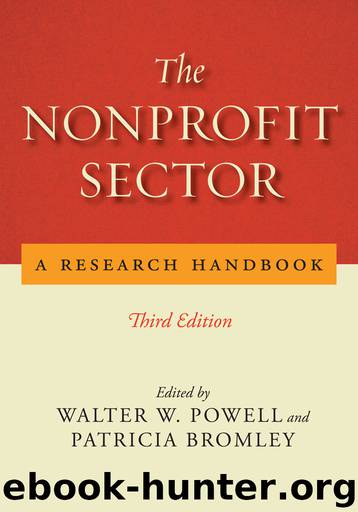The Nonprofit Sector by Walter W. Powell

Author:Walter W. Powell
Language: eng
Format: epub
Publisher: Stanford University Press
Published: 2020-06-15T00:00:00+00:00
Figure 18.1 Composition of K–12 schools by sector
Figure 18.2 Higher education enrollment by sector and level
K–12 Schools
Despite the tendency toward normative and coercive isomorphism across K–12 organizational sectors and types (DiMaggio and Powell 1983), there are persistent differences in organizational characteristics of K–12 schools across sectors and with respect to organizational forms. Table 18.1 identifies characteristics of K–12 schools for the four distinct organizational forms we have identified: traditional public, charter public, private secular, and private religious schools. Most schools across organizational forms are at the elementary level, which are smaller on average than secondary schools, with the exception of charter schools (average enrollment in traditional public elementary schools is 492; in traditional public secondary schools, 700; elementary charter schools, 379; secondary charter schools, 306). Although traditional public schools are rarely a combination of elementary and secondary schools, 20 percent to 30 percent of charter and private schools are some combination of the two. Enrollments at combined charter schools are similar to traditional secondary schools with approximately 630 students on average. Religious private nonprofit schools are considerably larger than their secular counterparts, with the exception of combined elementary/secondary private schools, which are similar in terms of enrollments regardless of the presence or absence of religious affiliation.
Approximately 50 percent of both traditional public and charter schools are classified as low-income—more than half of students receive free/reduced-price lunches. However, a higher proportion of charter schools have student bodies where more than 75 percent of students receive free/reduced-price lunches. Conversely, most private schools do not participate in the National School Lunch Program (NSLP). Of the private schools that do participate in the NSLP, religious schools are more likely than secular schools to have high poverty levels.
Regarding the racial/ethnic composition of public schools, as Table 18.1 shows, charter schools are less likely to be majority-white and significantly more likely to be either majority-black or majority-Hispanic. Moreover, charter schools are more likely than traditional public schools to have student compositions in which more than 90 percent of students are black or more than 90 percent of students are Hispanic. These statistics underlie a body of literature suggesting that school choice, driven by charter school availability, may be a driving force in maintaining racial school segregation (Perry 2017). Research along these lines indicates that charter schools may tend to be more racially segregated than their surrounding public school zones (Gulosino and d’Entremont 2011; Frankenberg, Siegel-Hawley, and Wang 2011). In contrast, the private nonprofit sector is much more likely to serve primarily white students: 77 percent of nonprofit religious schools and 55 percent of nonprofit secular schools are majority-white; 41 percent of nonprofit religious schools and 22 percent of nonprofit secular schools are more than 90 percent white.
With regard to faculty, teachers in public schools have higher levels of educational attainment than those in the nonprofit sector; private-school teachers are approximately four times as likely to have less than a bachelor’s degree than their public-school counterparts. However, the private sector, across organizational forms, is marked by considerably lower student–teacher ratios.
Download
This site does not store any files on its server. We only index and link to content provided by other sites. Please contact the content providers to delete copyright contents if any and email us, we'll remove relevant links or contents immediately.
| Biographies | Company Profiles |
| Economic History |
Pale Blue Dot by Carl Sagan(4907)
The Rules Do Not Apply by Ariel Levy(4844)
Goodbye Paradise(3724)
Ogilvy on Advertising by David Ogilvy(3503)
Liar's Poker by Michael Lewis(3367)
Delivering Happiness by Tony Hsieh(3363)
Into Thin Air by Jon Krakauer(3308)
Purple Cow by Seth Godin(3137)
Rogue Trader by Leeson Nick(2975)
The Social Psychology of Inequality by Unknown(2936)
The Airbnb Story by Leigh Gallagher(2797)
4 - Harry Potter and the Goblet of Fire by J.K. Rowling(2650)
The Mind Map Book by Tony Buzan(2510)
Bossypants by Tina Fey(2463)
Claridge's: The Cookbook by Nail Martyn & Erickson Meredith(2359)
All the President's Men by Carl Bernstein & Bob Woodward(2326)
Six Billion Shoppers by Porter Erisman(2267)
Master of the Game by Sidney Sheldon(2240)
Alibaba by Duncan Clark(2037)
